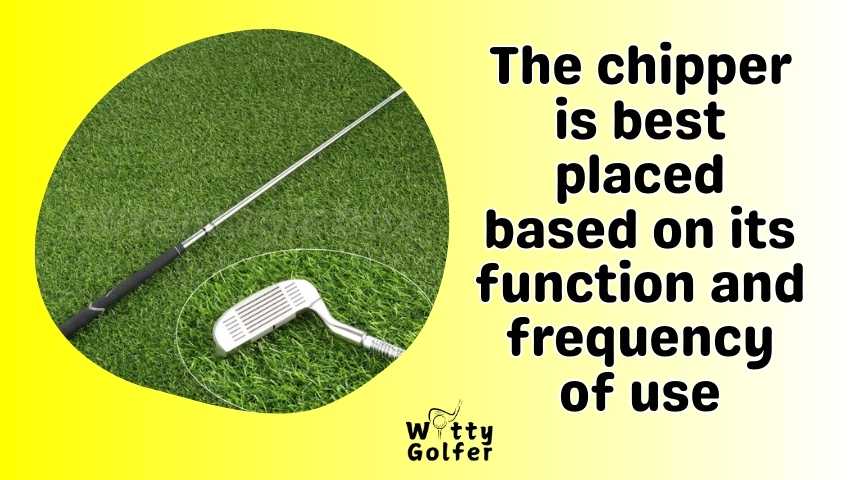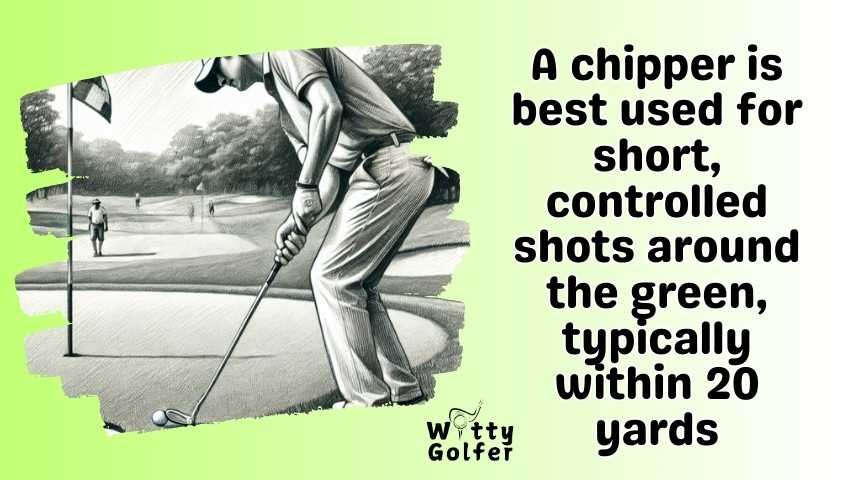A chipper in golf is a specialized club designed to simplify short-distance shots around the green. It allows golfers to execute low-trajectory chip shots that result in minimal airtime and a controlled roll toward the hole.
The chipper combines features of a putter and a wedge, making it particularly useful for players who struggle with traditional short-game techniques.

| Category | Data |
|---|---|
| Average Loft (Degrees) | 30°–37° |
| Common Use Cases | Shots within 30 yards of the green |
| Preferred User Base | Beginners and high-handicap golfers |
| Usage Increase (2020–2023) | 25% growth in recreational golf players |
| Price Range (USD) | $40–$120 |
What is a Chipper?
A chipper is a specialized golf club designed to help golfers execute short, low-lofted shots around the green. It combines features of a putter and a wedge, allowing players to make controlled chip shots that roll toward the hole with minimal air time. The chipper is an excellent tool for golfers who struggle with traditional wedges or want more consistency with their short-game shots.
Characteristics of a Chipper
A chipper has distinct characteristics that set it apart from other clubs in a golfer’s bag. These features include:
| Feature | Description |
|---|---|
| Loft | Typically ranges between 30° and 37°, similar to a 7- or 8-iron. |
| Design | Features a wide sole and a straight leading edge for clean contact with the ball. |
| Length | Similar to a putter, usually shorter than standard irons or wedges. |
| Lie Angle | More upright to accommodate a putting-like stance and stroke. |
| Grip | Often resembles a putter grip for better control. |
These attributes make the chipper user-friendly, particularly for beginners and high-handicap golfers.

How Does a Chipper Work?
The chipper is designed to simplify the chipping motion, making it more like a putting stroke. The golfer swings the club in a pendulum motion, using minimal wrist action. This technique produces a low trajectory with a controlled roll, helping the ball land softly and roll toward the target.
When to Use a Chipper
A chipper is ideal for specific situations on the golf course. Here’s when you should consider using it:
1. Around the Green
- When the ball is a short distance from the green, and you need to get it rolling quickly, the chipper is a reliable option. It eliminates the complexity of high-lofted shots and provides better control.
2. Fringe or Fairway Lies
- If your ball is resting on the fringe or in the fairway, the chipper’s wide sole ensures clean contact with minimal risk of digging into the turf.
3. Avoiding Thin or Fat Shots
- Golfers who struggle with consistency in chipping often use the chipper to reduce the chances of hitting the ball too thin (skulling it) or too fat (chunking it).
Advantages of Using a Chipper
1. Easy to Use
The chipper’s design makes it user-friendly, requiring less technical skill compared to wedges or irons. It’s especially helpful for golfers who are new to the game or lack confidence in their short game.
2. Improves Consistency
With a chipper, you can produce consistent results by using a putting-like stroke. This approach reduces variability and builds confidence.
3. Versatility
The chipper is effective in various situations, from the fringe to slightly off the green. Its design allows you to handle different lies without needing multiple clubs.
4. Reduces Stress
For many golfers, the short game can be intimidating. The chipper simplifies shot execution, helping players approach their shots with a relaxed mindset.
Disadvantages of a Chipper
While a chipper has many benefits, it may not suit every golfer or situation. Here are some potential drawbacks:
| Disadvantage | Explanation |
|---|---|
| Limited Shot Variety | A chipper is designed for specific situations and cannot replace wedges entirely. |
| Not Tournament Legal | Some competitions may restrict the use of chippers with non-conforming features. |
| Less Effective for Long Chips | For longer chip shots or bunker play, wedges are more versatile. |

How to Use a Chipper Effectively
Using a chipper requires a slight adjustment in your stance and technique. Follow these steps for better results:
1. Setup
- Take a narrow stance, similar to your putting stance.
- Position the ball slightly back in your stance for a downward strike.
- Grip the club with a putting-like grip for stability.
2. Swing
- Use a pendulum motion, keeping your wrists firm.
- Focus on controlling the distance and direction with your shoulders and arms.
- Avoid excessive wrist action to maintain consistency.
3. Practice
- Spend time practicing with the chipper to develop a feel for distance and roll.
- Experiment with different lies and slopes to gain confidence in various conditions.
Chipper vs. Wedge: What’s the Difference?
Golfers often wonder how a chipper compares to a traditional wedge. Here’s a quick comparison:
| Aspect | Chipper | Wedge |
|---|---|---|
| Loft | Lower loft (30°-37°) | Higher loft (45°-60°) |
| Shot Type | Low flight with more roll | Higher flight with less roll |
| Skill Requirement | Easier to use for beginners | Requires more skill and practice |
| Versatility | Limited to chipping situations | Suitable for various short-game scenarios |
While both clubs are valuable, the chipper is a simpler option for straightforward shots near the green, whereas wedges offer more versatility for different lies and distances.
Is a Chipper Right for You?
A chipper is an excellent choice for golfers who:
- Struggle with traditional wedges.
- Want a more straightforward approach to chipping.
- Prefer a putting-like stroke for better consistency.
However, advanced players or those with strong short-game skills may prefer wedges for their versatility.
Popular Chipper Models
If you’re considering adding a chipper to your bag, here are some popular models:
| Brand | Model | Features |
|---|---|---|
| Cleveland Golf | Smart Sole Chipper | Wide sole, forgiving design, ideal for beginners. |
| Odyssey | X-Act Tank Chipper | Heavy head for stability, excellent for control. |
| Wilson | Harmonized Chipper | Affordable, classic design, easy to use. |
These models cater to a range of preferences and budgets, making it easy to find the right chipper for your game.
4 Tips for Choosing the Right Chipper
When selecting a chipper, consider the following factors:
- Loft: Choose a loft that suits your typical chipping distances.
- Weight: A heavier clubhead can provide more control.
- Grip Style: Opt for a putter-like grip for familiarity.
- Price: Chippers are usually affordable, so choose one that fits your budget.
How does a golf chipper differ from a traditional wedge?
A golf chipper has a shorter shaft, a loft of around 32-37 degrees, and a design that promotes controlled, low-flying shots. In contrast, a traditional wedge, such as a lob wedge, is more versatile for high-lofted shots, flop shots, and bunker edge shots. The chipper’s low-loft design and putter grip make it a reliable tool for delicate, low-trajectory shots, while wedges offer an array of shots for different situations.
What are the benefits of using a chipper in golf?
The chipper provides benefits for golfers by simplifying short-game shots. These include:
- Consistency in chip shots: Its built-in lean-forward design promotes a smooth stroke for improved chip shots.
- Ease of use: The shorter shaft and putter-like grip are beginner-friendly and reduce the risk of mishits.
- Control on shots: Ideal for greenside shots, fringe shots, and approach shots.
- Specificity: Designed for a 2-30 yards range, it excels at critical shots like bunker edge shots and delicate, low-flying shots.
What is the degree of loft in a chipper?
Most golf chippers have a loft between 32 and 37 degrees, with 34-35 degrees being the most common. This degree of loft strikes a balance between enough lift to get the ball airborne and a low trajectory for a smooth roll toward the hole.
How is a chipper’s design different from other golf clubs?
A chipper’s design elements combine the iron head design with features of a putter. Its clubhead design combines a cavity-backed design for forgiveness, a flat shot face for consistency, and a shorter shaft for easier control. Unlike traditional wedges, it has a built-in lean-forward design for enhanced performance in chipping situations.
Who should use a chipper golf club?
Chippers for golfers are ideal for a category of players like beginner players, novice golfers, intermediate golfers, and average golfers. Even experienced players or seasoned golfers can benefit from the chipper’s ability to deliver consistent, low-trajectory shots in specific situations.
Are golf chippers legal in official tournaments?
The legality of golf chippers depends on their adherence to equipment rules set by governing bodies like the USGA and R&A. Most chippers that follow the characteristics of golf clubs within these rules are tournament-legal. However, a two-sided chipper or one with unconventional designs might not be allowed.
Can a chipper improve my game in golf?
Yes, a chipper can be an effective golf club for improving the short game in golf. By offering enhanced control and consistency for challenging shots like fringe shots or bunker edge shots, it can help amateur golfers, as well as avid golfers, lower their scores and build confidence in their game of golf.
What is the proper chipping technique with a chipper?
To master the art of chipping with a chipper:
- Use a putting-like stroke with minimal wrist movement.
- Position the ball slightly back in your stance for optimal ball contact.
- Focus on delicate, low-flying shots and punch shots for controlled results.
- Practice consistency in shot selection and distance control.
How does the shorter shaft of a chipper help?
The shorter shaft in a chipper, similar to that of a putter, promotes a comfortable stance and controlled stroke. It helps golfers avoid horrid shots caused by excessive wrist action, leading to improved shot accuracy and better control in critical shots like greenside or approach shots.
What are some top brands for golf chippers?
Brands like Cleveland Golf, Thomas Golf, and Dunluce Golf offer some of the best chipper options. These brands focus on creating effective golf club designs with advanced features to suit the demands of golfers at different skill levels.
Can a chipper handle an array of shots?
While a chipper excels at specific shots like fringe shots, greenside shots, and delicate, low-flying shots, it is not as versatile as other clubs like a golf wedge. For an array of shots, including high-lofted shots and flop shots, versatile clubs like a lob wedge or traditional wedge may be better suited.
Is a chipper a good investment for my golf equipment collection?
Yes, a chipper can be a valuable tool for your golf club collection. It is an essential tool for enhancing your chipping game and offers huge differences in consistency and control for short-game shots. As part of an array of golf clubs, it complements versatile clubs like wedges, making it a smart golf equipment investment.
Are custom golf clubs available for chippers?
Yes, custom golf clubs, including chippers, are available. These options allow individual golfers to select golf shafts, golf grips, and other golf club components to match their preferences and playing style.
How does a chipper compare to hybrid short-game clubs?
A chipper is more specialized for controlled, low-flying shots, while hybrid short-game clubs offer versatility for a wider range of shots. Both are excellent tools, but the chipper’s design focuses on simplifying the chipping game, making it suitable for delicate and precise chip shots.
Can I use a chipper on any golf course type?
Yes, a chipper can be used effectively on various golf course types. Its ability to handle challenging shots near the green makes it a reliable tool regardless of the course’s design or conditions.
How can a chipper affect my golf career?
Incorporating a chipper into your array of golf clubs can positively impact your golf career, especially for amateur golfers or those working on their short-game consistency. It can help you build confidence, enhance shot accuracy, and handle critical shots under pressure during any golf season.
By understanding the design elements and benefits of a chipper, golfers of all levels can make the most of this valuable tool in their game.
Final Words
The chipper is a game-changing tool for many golfers, offering simplicity and consistency for short-game shots. By understanding its design, purpose, and proper technique, you can use this versatile club to improve your performance around the greens. Whether you’re a beginner or looking to simplify your approach, a chipper might be the key to lowering your scores and enhancing your overall enjoyment of the game.